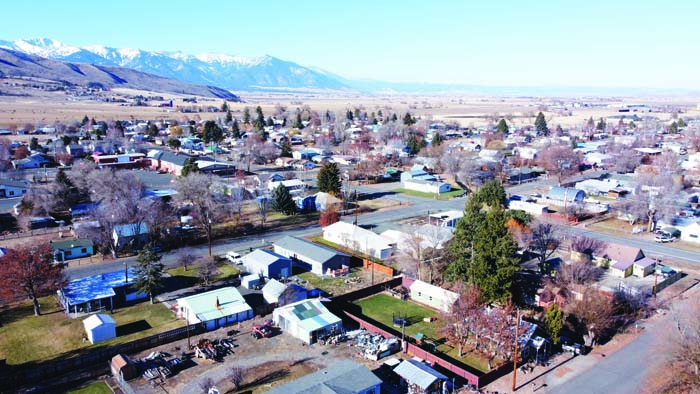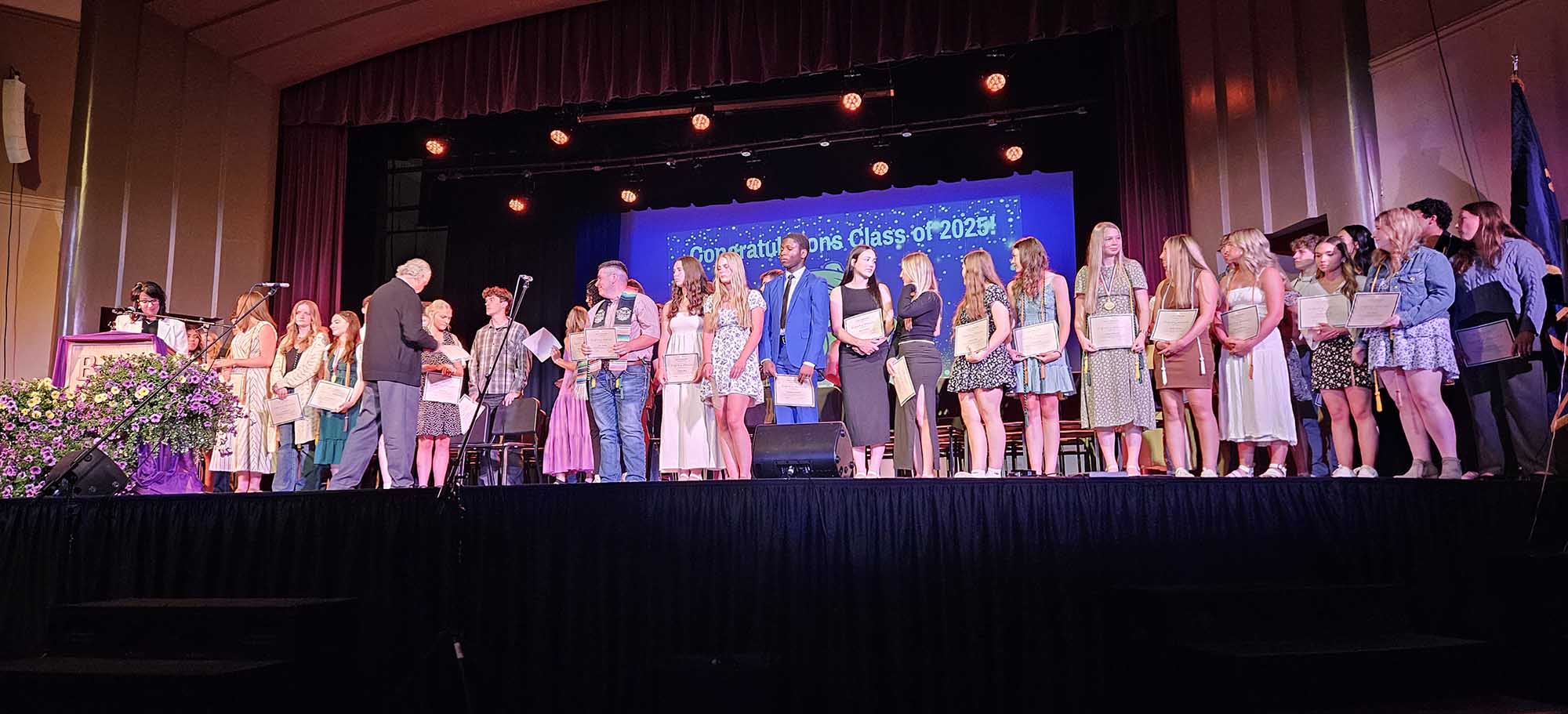Getting high marks: Class of 2023 achieves second-highest graduation rate ever in Oregon
Published 11:00 am Friday, January 26, 2024

- Graduating senior Allie Aguilera embraces someone in the crowd during the Cove High School graduation ceremony on Saturday, May 27, 2023.
SALEM — The 37,700 students that made up Oregon’s 2023 high school graduating class posted the second-highest four-year graduation rate — 81.3% — ever recorded by the state.
The Oregon Department of Education, which presented the statewide graduation rates Tuesday, Jan. 23, stressed that the Class of 2023 shouldered the full brunt of the COVID-19 pandemic as those students were starting high school when the pandemic began.
Peter Rudy, a spokesperson for the Oregon Department of Education, said the 81.3% graduation rate is especially noteworthy given all the challenges the students faced from the onset of their freshman year.
“Most of Oregon’s schools did not return to in-person instructional models consistently until the end of 2021, at the end of 10th grade for this cohort,” he said.
“This group of students demonstrated the ability to adapt to different ways of learning and demonstrating understanding, to engaging with peers and educators in online environments, and to taking care of themselves and sustaining engagement without many of the social motivators that prior classes had been able to avail themselves of, including sports, clubs and extracurricular activities — and even socializing with friends outside of school. Through all of these disruptions, they kept learning and striving. That is commendable.”
The mark is identical to the graduation rate the state saw in 2022 and a mere 1.3 percentage points below the all-time high of 82.6% set by the 2019-20 graduating class.
Also tabulated were Oregon’s five-year completion rates, which the Department of Education said complement the four-year graduation rate, while acknowledging that some students have different paths to achieving a high school credential and may need more than four years to do it. Oregon’s five-year completion rate stands at 86.6% for the Class of 2022 and is the third-highest rate ever reported.
The five-year completion rate is made up of students who earned a regular diploma, modified diploma, GED, adult high school diploma or extended diploma within five years of entering high school. Students who received a GED, adult high school diploma or extended diploma were classified as “other completers” in the Department of Education’s 2023 statewide graduation report.
“When ODE uses the term ‘other completers,’ we are referring to the three credentials (GED, adult high school diploma and extended diploma) that are added as ‘completers’ when calculating the five-year completer rate,” Rudy said.
Of the six counties that make up Northeastern Oregon, most either met or exceeded the statewide graduation rate. Morrow and Wallowa counties posted the highest rates in the region at 96.4% and 91.9%, respectively.
Baker County (80%), Umatilla County (80.4%) and Union County (82.9%) all either met or were slightly below the statewide graduation rate for the 2022-23 school year among Northeast Oregon counties.
Grant County was the outlier, reporting a 2022-23 graduation rate of 64.2%, down more than 14 percentage points from the 78.4% graduation rate the county reported for the 2021-22 school year.
Grant County’s situation is unique, with a pair of outlying statistics affecting the county’s overall graduation rate. Four of the county’s five high schools exceeded the state graduation rate.
Long Creek High School, with just four students in its 2022-23 graduating class, had a graduation rate of 50%. Oregon Connections Academy, an online virtual school that is part of the Prairie City School District, reported a graduation rate of 55% for the 2022-23 school year.
Prairie City High School itself reported an 85.7% graduation rate. But when the numbers for Oregon Connections Academy — which has a much larger enrollment — are factored in, the graduation for the district as a whole was pulled down to 57.9%.
All the other high schools in the county exceeded the statewide average. Grant Union had an 89.7% graduation rate, Dayville’s was 85.7% and Monument posted a sterling 100% graduation rate.
Oregon’s graduation requirements
Oregon has one of the more demanding sets of graduation requirements in the country when measured by course credits, according to the Oregon Department of Education. Students must earn 24 credits, complete personalized learning requirements and demonstrate proficiency in essential skills.
The essential skills Oregon students are required to be proficient in prior to graduation include reading comprehension; writing clearly and accurately; applying mathematics in a variety of settings; listening actively and speaking clearly and coherently; thinking critically and analytically; using technology to live, learn and work; demonstrating community and civic engagement; demonstrating global literacy; and demonstrating personal management and teamwork skills.
Prior to 2020, proficiency in three of those essential skills — reading comprehension, writing and applying mathematics — were determined via state-approved assessment options and classroom assessments. All other skills were embedded in the students’ K-12 curricula, combined with classroom assessments by teachers.
After 2020, all of those skills were embedded in students’ K-12 education coupled with classroom assessments by teachers. Classroom assessments take the form of formative and interim/benchmark tests.
The numbers
According to the Department of Education, there are 533,012 students in schools across Oregon who speak more than 300 languages. Those students are served by 81,826 educators spread across 1,270 public schools, 131 charter schools and 19 education service districts.
Oregon’s statewide graduation rate has steadily ticked up over time. In 2013-14, the state’s graduation rate was 72%. It has risen every year since then, hitting 80% for the first time with the 2018-19 graduating class.
The five-year completion rate, like the four-year rate, also has trended upward over time. This year’s rate is 0.3 percentage point higher than the rate in 2021 and 5.2 points higher than the class of 2014’s five-year completion rate.
Among specific student groups, students who were English language learners at any point during high school saw their graduation rates rise by 2.8 percentage points when compared to the 2022 graduation class, the highest such rise of any student group.
Homeless students and career technical education concentrators showed the second-highest graduation rate spike in the state, with both groups seeing a 2.0 percentage point increase in graduation rates in comparison to the 2022 class. CTE concentrators graduated at some of the highest rates among all student groups at 95% for 2023, a mark bested only by talented and gifted students, who graduated at a 96.3% clip in 2023.
Among ethnic groups, Native Hawaiian/Pacific Islanders saw the largest jump in graduation rates, rising by 1.3 percentage points when compared to 2022. Both white and multi-racial students saw a small 0.1 percentage point increase over 2022 graduation rates.
The 2023 graduation rates of first-time English learners, special education students and houseless students are the highest ever recorded.
There were some slight declines among student groups and ethnicities, however.
The largest dip in graduation rates was among American Indian/Alaska Native students, who saw a 0.7 percentage point drop in their graduation rates from 2022 to 2023. African American and female students experienced a 0.6 percentage point drop in their graduation rates from 2022 to 2023.
For the first time, Oregon reported graduation rates of military-connected students (86.7%), recently arrived students (63.3%) and students with experience in incarceration or detention (35.8%).
School districts react
Morrow County School District’s graduation rates have risen sharply over the past decade, shooting up from 76% in 2011-2012 to 96.8% for the 2022-23 school year.
The district’s superintendent, Matt Combe, was not available to comment for this article. In a press release, however, the district credited school staff and families for the high rates of graduation.
“We are incredibly proud of the Class of 2023; these students did not have a ‘real’ year of high school until their senior year and were able to maintain their focus on graduation. Superintendent Matt Combe credits the extremely dedicated school staff, educational partners, and families in the ongoing success of our students,” the press release stated.
Pendleton School District saw its graduation rate fall nearly five percentage points from 2022, to 76.7% in 2023. Matt Yoshioka, the district’s director of curriculum, instruction and assessment, said the COVID-19 pandemic played a large role in the graduation rate decline over the past year.
“(These students) were freshmen when everything shut down in March of their freshman year,” he said. “And coming back to sophomore year, certainly a lot of challenges, and so, you know, we still consider this somewhat of a success and being able to help those kids get through it. We feel like our staff worked really hard to make this happen and get those kids graduated.”
Yoshioka said the district is still trying to reverse a trend of students simply not attending school, which he said has become a much larger problem than it was before the pandemic.
“What we’re noticing is that the number of students who are not attending is growing,” he said. “It’s definitely much, much higher post-COVID.”
Despite those areas of concern, the district does have some bright spots associated with its 2023 graduation rates, most notably the Native American student graduation rate, which at 80% is just over 11 percentage points higher than the state average for that group.
“That’s a huge success of many years of hard work from all of our staff and our partnership with the (Confederated Tribes of the Umatilla Indian Reservation). We try to do all we can to help close any kind of achievement gaps,” Yoshioka said. “It certainly looks like that gap for Native American students is closing, which is a huge success and great to see.”
Hermiston School District also saw a slight downturn in overall graduation rates, from 80.4% in 2021-22 to 78.3% for the 2022-23 school year.
Scott Depew, the director of secondary education for the district, said officials weren’t blindsided by the dip in their graduation rate this year, attributing the drop to struggles during the pandemic.
“It’s no surprise. We track this and know where we’re going to fall every year,” he said. “It does identify a couple challenges. We’ve got to remember this class started their freshman year with the pandemic.”
Depew added that the district has a little room for improvement in order to get graduation rates to a level officials are comfortable with. Some of that work will come in the form of simply getting kids back into the classroom post-COVID.
“Like other schools, we’re struggling with attendance and truancy,” he said. “It has definitely been a challenge. It’s a big investment by districts to try and get kids to attend regularly.
“No one anticipated a pandemic, and the fallout from that is getting our kids back in school on a regular basis,” he added.
Cove School District in Union County saw a sizable increase in graduation rates from 2022, posting a nearly 4 percentage point increase in 2023 at 92.3%. Superintendent Earl Pettit said the district’s strong 2023 graduation rate can be attributed to the way it navigated the pandemic.
“Cove School District was only closed for in-person learning during that spring of 2020,” Pettit said. “We opened in the fall on time and never had a closure since fall of 2020 and we were in-person.”
Pettit stressed that the school district’s efforts to return to normalcy following the reopening of schools in the fall of 2020 had no impact on the health of students within the Cove School District.
Another strategy the Cove School District used to mitigate the pandemic’s long-term impact on students was to eliminate all online school offerings in 2021.
“We learned that the online was killing us — the student performance was always poor and we couldn’t get the students to advance very well,” he said. “I think we’re the only district in this region that doesn’t have anything to offer for online options.
“I think the most significant issue is that personal interaction between the teacher and the student,” Pettit added.
While the district does have a much higher graduation rate than the state average, Pettit said small schools like those in the Cove School District don’t use the state’s graduation averages as a measuring stick.
“Me, nor any of our school board members and even our high school principal I bet would have any idea what the state graduation rate is,” he said. “We don’t pay any attention to it.”
Instead, the district’s goal is always a 100% graduation rate, Pettit said.
“We don’t always meet that,” he said. “When we don’t meet that, the thing we look at is each student. We’re small enough that when you talk about your graduation rate — and I just happen to know the students — and if you do a breakdown of numbers, we’ve had the same number of kids not graduate two years in a row. The difference is the size of the class was different.””
The 2022-23 senior class at Cove High School numbered 26 students, 24 of whom graduated within four years.
Due to the small number of students within the district, Pettit said, a single kid not graduating can significantly alter their graduation rate.
“Trying to compare us to a state average or something, that doesn’t do any good,” he said. “We know each kid very well that did not graduate on time and how they got there, and we know all the interventions we should be doing.”
La Grande High School had a significant increase in its four-year graduation rate in 2023, with 142 of 168 students graduating, a rate of 84.5%.
That’s up from 68.9% for the Class of 2022.
Baker County
Baker High School’s graduation rate surpassed the Oregon average in 2023 and was nearly identical to the previous year.
Of the 110 students in the class of 2023, 94 had graduated within four years of starting high school, according to Oregon Department of Education statistics.
Baker’s four-year graduation rate of 85.5% exceeded the statewide average of 81.3%.
Baker High School’s four-year graduation rate in 2022 was 85.6%.
The rate for the class of 2021 was 82.8%. The statewide average that year was 80.6%.
Baker’s graduation rate was even higher in 2020 — 92.4% — but that figure wasn’t precisely comparable to other years due to the effects of the pandemic, which resulted in online classes for the entire spring 2020 semester. The 2020 graduates were allowed to finish with pass/fail rather than letter grades, and they did not have to supply performance work samples.
Greg Mitchell, then the BHS principal, acknowledged that the temporary changes prompted by the pandemic boosted the graduation rate.
Nonetheless, the BHS graduation rates for the past three classes were all higher than the last pre-pandemic class, 2019, when the four-year graduation rate was 78.6%.
Skye Flanagan, who has been BHS principal since the start of the 2021-22 school year, said the graduation rates the past few years show that “our kids are doing the right things.”
“I am truly proud of what we’re doing,” Flanagan said.
He believes one of the school’s advantages is the range of elective classes students can choose from, nearly 70 topics including engineering, computer science, music, business, welding and many more.
Having so many options, he said, can help students discover subjects in which they excel, which can keep those who might otherwise be prone to apathy focused on earning the credits they need to graduate.
In other school districts in and near Baker County, the four-year graduation rate for Huntington was 83.3% in 2023 (five of six students graduating). The 2022 rate in Huntington was 100%.
Powder Valley High School in southern Union County had a graduation rate above 95% last year, and 94.1% in 2022.
Pine Eagle High School in Halfway posted a graduation rate of 71.4% in 2023 (five of seven students), and 85% the previous year.





